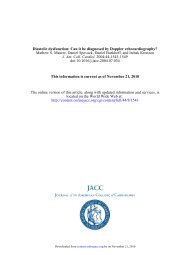Download Full Paper - Daniel Burkhoff MD PhD
Download Full Paper - Daniel Burkhoff MD PhD
Download Full Paper - Daniel Burkhoff MD PhD
Create successful ePaper yourself
Turn your PDF publications into a flip-book with our unique Google optimized e-Paper software.
1362 KOHMOTO ET AL Ann Thorac Surg<br />
MYOCARDIAL VASCULAR GROWTH AFTER TMR 1998;65:1360–7<br />
within the area immediately surrounding the channel<br />
remnant and in the neighboring area were counted on<br />
the factor VIII-stained sections. A vascular structure was<br />
counted as an “arterial structure” if it stained positive for<br />
factor VIII and was surrounded by at least one layer of<br />
smooth muscle cells. As indicated above, vessels within<br />
the core of the channel remnant or within fibrous tissue<br />
related to the channel remnant were not counted. Vessels<br />
on the boundary of the channel remnant (ie, arteries<br />
flanked on one side by granulation tissue and by normal<br />
myocardium on the other side) were included. Next, the<br />
number of smooth muscle or endothelial cells staining<br />
positive for PCNA were counted in these areas on sister<br />
sections stained with PCNA antibodies. Finally, the density<br />
of arterioles (arterioles/cm 2 myocardium) and the<br />
density of PCNA-positive cells were then calculated. All<br />
analyses were done under the microscope from the<br />
original slides.<br />
Results<br />
Fig 1. Low-power view of a typical laser channel remnant showing<br />
concentric ovals used to define the area immediately surrounding the<br />
channel remnant (0.6 1 cm, inner oval) and the neighboring region<br />
(1.0 1.4 cm, outer oval). Ovals and channel remnant are<br />
drawn with same scale to their relative sizes.<br />
Fig 2. Trichrome stained (A) and factor VIII immunostained (B) histologic<br />
sections about 2.5 weeks after holmium:YAG laser treatment.<br />
The original channel region is invaded by granulation tissue that<br />
includes significant amounts of vascularity both within and surrounding<br />
the channel remnant. Arrows point to examples of factor<br />
VIII-positive staining arterial structures that are surrounded by at<br />
least one layer of smooth muscle. (25 before 54% reduction.)<br />
The general appearance of myocardium 2 weeks after<br />
laser treatment is shown in the typical examples of Figure<br />
2 (holmium:YAG laser) and Figure 3 (CO 2 laser). For<br />
comparison, a typical sample of normal myocardium<br />
(obtained from the left circumflex, nonlased region) is<br />
shown in Figure 4; note that a sample containing a small<br />
artery was specifically identified for this sample. As we<br />
have observed previously, the trichrome-stained sections<br />
(Figs 2A, 3A) reveal that the original channel region has<br />
been invaded by granulation tissue that includes fibrosis<br />
and a large amount of vascularity. Because we have never<br />
identified any widely patent chronic channels with internal<br />
diameters similar to that of the original channel (800<br />
to 1,000 m), we have referred to these regions where<br />
channels were made as “channel remnants.” In the case<br />
of both examples, the vessels within the granulation<br />
tissue are of varying sizes and include capillaries, small<br />
arterioles, and frequently larger arteries with several<br />
layers of smooth muscle. There are vessels cut in crosssection<br />
(indicating that they are traveling in the epicardial-to-endocardial<br />
direction) and also vessels cut longitudinally<br />
(indicating that they are traveling radially out<br />
from the channel). Also seen in Figure 2 are crosssections<br />
of larger muscular arteries within the core of the<br />
channel remnant. As seen in the accompanying sections<br />
stained for factor VIII (Figs 2B and 3B), the arteries were<br />
endothelial lined. The general appearance of channel<br />
remnants made with both lasers exhibited a rather wide<br />
range of characteristics. However, it was not possible to<br />
distinguish between channels made with the two lasers.<br />
The factor VIII-stained tissue shown at low power<br />
magnification in Figures 2B and 3B also reveal vascularity<br />
on the border of the region of granulation tissue and in<br />
the area immediately surrounding the channel remnant,<br />
which again included vascular structures of various sizes.<br />
These vessels appeared to be originating from within the<br />
channel remnant and extend out into the surrounding<br />
normal myocardium. Arrows in these figures point to<br />
some of the smooth muscle-lined vessels found on the<br />
edge of the channel remnant and in the surrounding<br />
normal myocardium. Note that identification of a muscular<br />
layer in the smaller of these arteries, not always





